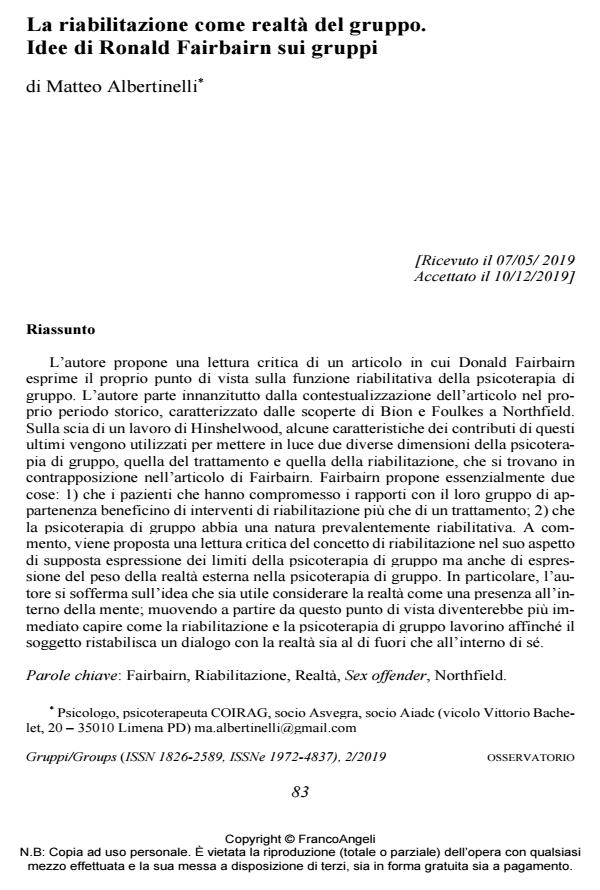Rehabilitation as the reality of the group. Ronald Fairbairn’s ideas on groups
Journal title GRUPPI
Author/s Matteo Albertinelli
Publishing Year 2020 Issue 2019/2
Language Italian Pages 13 P. 83-95 File size 158 KB
DOI 10.3280/GRU2019-002007
DOI is like a bar code for intellectual property: to have more infomation
click here
Below, you can see the article first page
If you want to buy this article in PDF format, you can do it, following the instructions to buy download credits

FrancoAngeli is member of Publishers International Linking Association, Inc (PILA), a not-for-profit association which run the CrossRef service enabling links to and from online scholarly content.
The author proposes a critical reading of an article where Donald Fairbairn ex-presses his point of view on the rehabilitative function of group psychotherapy. The author begins by contextualizing Fairbairn’s article in its own historical period, which was characterized by Bion and Foulkes’ discoveries at Northfield’s. Follow-ing an article by Hinshelwood, the author utilizes the characteristics of the work of the latters as an example of two particular dimensions of group psychotherapy, that of treatment and that of rehabilitation, which are compare in Fairbairn’s arti-cle. Fairbairn essentially proposes: 1) that patients who have a compromised rela-tionship with the group they belong to benefit more from rehabilitation interven-tions than from treatment interventions; 2) that group psychotherapy has a preva-lently rehabilitative nature. To comment on Fairbairn’s work, the author then pro-poses to analyse the concept of rehabilitation both as something that supposes to manifest the limits of group psychotherapy and also as the expression of the weight of external reality in group psychotherapy.The author is especially con-cerned with the usefulness of thinking about reality as a presence inside of a sub-ject’s mind; the author proposes that starting from this point of view would make it more clear how rehabilitative intervention and group psychotherapy work to re-establish a dialogue between a subject and the reality outside and inside him.
Keywords: Fairbairn, Rehabilitation, Reality, Sex offender, Northfield.
- Abraham N. e Torok M. (1987). L’écorce et le noyau. Paris: Flammarion (trad. it.: La scorza e il nocciolo. Roma: Borla, 1993).
- Albertinelli M. (2018). Edifici fascisti e rappresentazione della violenza. Regressione ed elaborazione psichica nell’individuo, nel gruppo e nella civiltà. Gruppi, 1: 107-123. DOI: 10.3280/GRU2018-001007
- Aulagnier P. (1991). La violenza dell’interpretazione. Borla: Roma, 2005.
- Bion W.R (1961). Esperienze nei gruppi. Roma: Armando, 1971.
- Bion W.R. (1962). Apprendere dall’esperienza. Roma: Armando, 1972.
- Bion W.R. (1963). Gli elementi della psicoanalisi. Roma: Armando, 1973.
- Bion W.R. (1965). Trasformazioni. Roma: Armando, 1973.
- Bion W.R. (1982). La lunga attesa. Autobiografia, 1897-1919. Roma: Astrolabio, 1986.
- Bion W.R. (1985). A ricordo di tutti i miei peccati. L’altra faccia di un genio. Roma: Astrolabio, 2001.
- Bion W.R. e Rickman J. (1943). Le tensioni all’interno del gruppo durante la terapia e il loro studio come suo compito. In: Bion W.R. (1961). Esperienze nei gruppi. Roma: Armando, 1971.
- Corbella S. (2003). Storie e luoghi del gruppo. Milano: Raffaello Cortina.
- Fairbairn W.R.D. (1943a). The Repression and the Return of Bad Objects (with Special Reference to the War Neuroses). In: Fairbairn W.R.D., Psychoanalytic Studies of the Personality. London: Routledge & Kegan Paul, 1952.
- Fairbairn W.R.D. (1943b). The War Neuroses. Their Nature and Significance. In: Fairbairn W.R.D., Psychoanalytic Studies of the Personality. London: Routledge & Kegan Paul, 1952.
- Fairbairn W.R.D. (1946a). Object-Relationship and Dynamic Structure. In: Fairbairn W.R.D., Psychoanalytic Studies of the Personality. London: Routledge & Kegan Paul, 1952.
- Fairbairn W.R.D. (1946b). The Treatment and Rehabilitation of Sexual Offenders. In: Fairbairn W.R.D., Psychoanalytic Studies of the Personality. London: Routledge & Kegan Paul, 1952.
- Fairbairn W.R.D. (1952). Psychoanalytic Studies of the Personality. London: Routledge & Kegan Paul (trad. it.: Studi psicoanalitici sulla personalità. Torino: Bollati Boringhieri, 1977).
- Foulkes S.H. (1964). Therapeutic Group Analysis. London: Karnac, 1984.
- Foulkes S.H. & Lewis E. (1944). Group Analysis: A study in the Treatment of Groups on Psycho-analytic Lines. In: Foulkes S.H. (1964). Therapeutic Group Analysis. London: Karnac, 1984.
- Freud S. (1919). Introduzione. In: Psicoanalisi delle nevrosi di guerra. OSF, 9. Torino: Bollati Boringhieri.
- Hinshelwood R.D. (1999). How Foulkesian Was Bion? J. Group Analysis, 32: 469-488. DOI: 10.1177/0533316992207698
- Jones E. (1942). Preface. In: Fairbairn W.R.D. (1952). Psychoanalytic Studies of the Personality. New York: Routledge (trad. it.: Fairbairn W.R.D., Studi psicoanalitici sulla personalità. Torino: Bollati Boringhieri, 1977).
- Kaës R. (2009). Les alliances inconscientes. Paris: Dunod (trad. it.: Le alleanze inconsce. Roma: Borla, 2010).
- Kaës R. (2012). Le Malêtre. Paris: Dunod (trad. it.: Il Malessere. Roma: Borla, 2014).
- Nichol B. (2000). Bion and Foulkes at Northfield: The Early Development of Group Psychology in Britian. Cary, NC: Business Coach Institute.
- Ogden T.H. (1989). Il limite primigenio dell’esperienza. Roma: Astrolabio, 1992.
- Ogden T.H. (2009). Rediscovering Psychoanalysis. New York: Routledge.
- Il ritiro sociale è un'esperienza che ci riguarda tutti? Riflessioni sull'hikikomori a partire da un film contemporaneo Matteo Albertinelli, in GRUPPI 1/2024 pp.203
DOI: 10.3280/gruoa1-2022oa17973
Matteo Albertinelli, La riabilitazione come realtà del gruppo. Idee di Ronald Fairbairn sui gruppi in "GRUPPI" 2/2019, pp 83-95, DOI: 10.3280/GRU2019-002007